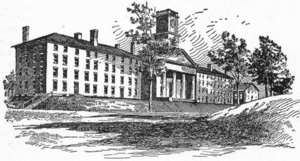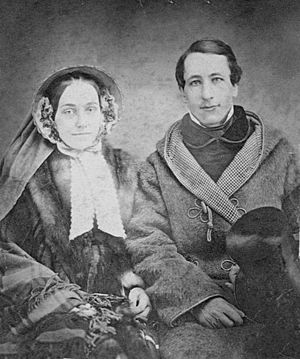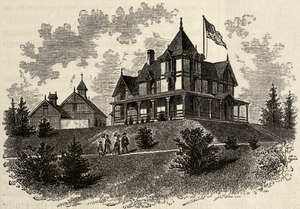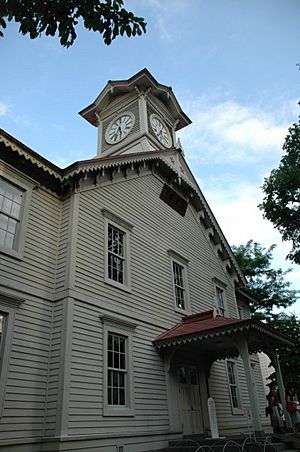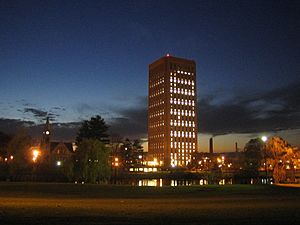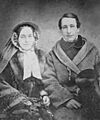William S. Clark facts for kids
Quick facts for kids
William Smith Clark
|
|
|---|---|
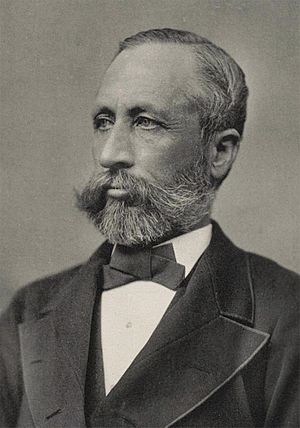
William S. Clark c. 1876
|
|
| President of the Massachusetts Agricultural College (now the University of Massachusetts Amherst) | |
| In office 1867–1879 |
|
| President of the Sapporo Agricultural College (now the Hokkaido University) | |
| In office 1876–1877 |
|
| Member of the Massachusetts House of Representatives | |
| In office 1864 – 1865, and 1867 |
|
| Presidential Elector, 1864 | |
| Personal details | |
| Born | July 31, 1826 Ashfield, Massachusetts |
| Died | March 9, 1886 (aged 59) Amherst, Massachusetts |
| Signature |  |
| Military service | |
| Allegiance | |
| Branch/service | |
| Years of service | 1861–1863 |
| Rank | |
| Commands | |
| Battles/wars | American Civil War |
William Smith Clark (July 31, 1826 – March 9, 1886) was an American professor who taught chemistry, botany, and zoology. He also served as a colonel during the American Civil War and was a key leader in agricultural education. Clark spent most of his life in Amherst, Massachusetts.
He graduated from Amherst College in 1848 and earned a doctorate in chemistry in 1852 from the University of Göttingen in Germany. He then taught chemistry at Amherst College until 1867. During the Civil War, he took a break from teaching to serve with the 21st Regiment Massachusetts Volunteer Infantry. He eventually became a colonel and led this unit.
In 1867, Clark became the third president of the Massachusetts Agricultural College (MAC), which is now the University of Massachusetts Amherst. He was the first to hire teachers and welcome students to the college. Even though MAC faced criticism from politicians and newspapers, Clark's work in creating a new kind of school gained international attention.
Officials from Japan were especially interested in Clark's work. They wanted to quickly modernize their country after the Meiji Restoration. In 1876, the Japanese government hired Clark as a foreign advisor to start the Sapporo Agricultural College (SAC), now Hokkaido University. During his eight months in Sapporo, Clark successfully organized SAC. He also had a big impact on the scientific and economic growth of Hokkaido island. Clark's famous words to his Japanese students, "Boys, be ambitious!" (「少年よ大志を抱け Shōnen yo, taishi o idake」), became a well-known motto in Japan.
After leaving MAC in 1879, Clark started a mining company. However, his business partner was dishonest, and the company quickly failed. This ruined Clark's reputation and finances. The stress from this situation affected his health. He died in Amherst in 1886 from heart disease.
Contents
Early Life and Education
William Smith Clark was born in Ashfield, Massachusetts, on July 31, 1826. His father, Atherton Clark, was a country doctor. Around 1834, his family moved to Easthampton, Massachusetts. Clark attended Williston Seminary (now the Williston Northampton School) in Easthampton.
He then went to Amherst College in 1844. He was a very good student and joined the Phi Beta Kappa honor society. He graduated in 1848. After college, Clark taught chemistry at Williston Seminary from 1848 to 1850. In 1851, he traveled to Germany to study chemistry and botany at Georgia Augusta University, now known as the University of Göttingen. He earned his Ph.D. in chemistry there in 1852.
Later that year, Clark returned to Amherst. He became a professor of chemistry at Amherst College, a position he held until 1867. He also taught zoology and botany for several years. Clark became very interested in agricultural education after his time in Germany. In 1853, he started a new science program for studying agriculture. However, this program did not attract many students and was stopped in 1857. Clark realized that a new type of school was needed to teach agriculture effectively. He worked with agricultural groups to gain support for an agricultural college in Massachusetts.
Family Life
On May 25, 1853, Clark married Harriet Keopuolani Richards Williston. Harriet was the daughter of American missionaries to the Kingdom of Hawaii. She and her brother were sent from Hawaii to live with Samuel Williston, a wealthy businessman, so they could attend Williston Seminary. Samuel Williston became an important supporter of Clark's career. He was a major helper of Amherst College and a very important person in western Massachusetts.
William and Harriet Clark had 11 children, but only 7 of them lived to be adults. One of their sons, Hubert Lyman Clark, became a well-known zoologist, studying animals.
Serving in the Civil War
Clark's teaching career was put on hold by the American Civil War. He strongly supported the Union side in the war. He helped train students in military drills at Amherst College and encouraged many to join the army. In August 1861, he became a major in the 21st Regiment Massachusetts Volunteer Infantry. He served with this regiment for almost two years. He became a lieutenant colonel in 1862 and a colonel from 1862 to 1863, leading the regiment.
The 21st Massachusetts was first stationed in Maryland. In January 1862, the regiment joined a group of soldiers heading to North Carolina. Clark took command of the regiment in February 1862. He led them in the Battle of New Bern on March 14, 1862. During this battle, Clark became known for his bravery. His regiment charged an enemy cannon, and he stood on top of it, urging his soldiers forward. This cannon was the first one captured by the Union Army in that battle. It was later given to Amherst College.
After July 1862, Clark's regiment moved to Virginia and joined the Army of the Potomac. They fought in major battles like Second Bull Run, Antietam, and Fredericksburg. The regiment lost many soldiers during the Battle of Chantilly on September 1, 1862. In the chaos of that battle, Clark got separated from his regiment. He wandered for four days before finding the army again. While he was missing, newspapers mistakenly reported that he had been killed.
Clark became less enthusiastic about the war after the Battle of Fredericksburg. In this battle, the Union Army suffered huge losses. By April 1863, his regiment had lost so many soldiers that it barely existed. Clark resigned from the army and returned to Massachusetts.
Leading the Massachusetts Agricultural College
The idea for an agricultural college in Massachusetts started long before Clark got involved. However, little progress was made until the Morrill Land Grant Act was passed in 1862. This law gave federal land to each state. The money from selling this land was meant to help create colleges focused on agriculture and mechanical arts. Massachusetts decided to use this program and started the Massachusetts Agricultural College (MAC) in April 1863.
Clark and others believed that scientific progress was not reaching farmers. Clark felt that farmers in Massachusetts did not have good access to higher education. He believed this was causing farming to decline. He wrote that farmers should have the same high-level education as people in medicine or law. He also worried that if farming continued to decline, it would be seen as a low-status job.
Clark resigned from the army one month after MAC was created. When he returned to Amherst, he worked hard to convince state officials to build the college in Amherst. Other cities like Springfield and Lexington were also considered. Clark was elected to the Massachusetts Legislature in 1864. He helped secure $50,000 for Amherst to build the college. This convinced the college leaders to choose Amherst.
MAC had two presidents in its first four years and still had no teachers, students, or finished buildings by 1867. Clark became president in 1867. He immediately hired teachers and finished the building plans. Clark's strong leadership allowed the college to welcome its first class of 49 students. Besides being president, he also taught botany and horticulture.
Even though the college started well, it had low student numbers in the 1870s. Clark was disappointed that farmers did not support the college more. He felt it was "astounding" that most of the 75,000 farmers in Massachusetts seemed not to care about the college.
By the end of his time as president of MAC, Clark faced growing criticism from newspapers and politicians in Boston. MAC was getting into debt, and some people called it a failure. Clark was angry about this criticism. He resigned in 1879.
Clark also served on a commission in 1863 to consider starting a state military academy. He was a presidential elector in 1864 and a representative in the Massachusetts House of Representatives in 1864–1865 and 1867. He was also a member of several scientific groups. In 1868, Clark became a Fellow of the American Academy of Arts and Sciences.
Impact in Japan
In 1876, the government of Japan invited Clark to establish the Sapporo Agricultural College (SAC), which is now Hokkaido University. After the Meiji Restoration in 1867, Japan's new government wanted to modernize quickly. They hired many European and American experts to help, who were called "hired foreigners" (oyatoi gaikokujin).
Japan's Minister to the United States, Mori Arinori, asked for advice on finding a good agricultural college model. He was told about MAC and then recommended Clark to the Japanese government.
Clark signed his contract with the Japanese government on March 3, 1876. There were some differences in how his job title was translated, but Clark had full support to organize SAC. He had a lot of authority over the college while he was in Japan.
Clark spent eight months in Sapporo from 1876 to 1877. He was happy with the cooperation he received from the Japanese government. SAC was organized in just one month. Clark wrote to his wife, "I am actually rebuilding MAC... on the other side of the earth." At SAC, Clark introduced the first American-style farm and barn in Japan. He also started the first college military unit in the country. He brought new crops and new ways of farming, fishing, and raising animals.
Clark worked closely with Kuroda Kiyotaka, the Governor of Hokkaido, who later became Prime Minister of Japan. Both men respected each other and had military experience. Their good relationship helped Clark achieve many things in Sapporo. Clark gave advice on many topics, from turning traveling fishermen into permanent settlers to starting a textiles industry. Clark was surprised by how much influence he had. He wrote to his wife, "Governor Kuroda consults me constantly and always follows my advice."
Clark not only helped develop Hokkaido but also had a strong personal effect on the first students of SAC. His message of ambition and personal improvement resonated deeply with his Japanese students. He encouraged them to "Be gentlemen."
Even though the Japanese government did not allow teaching the Bible in government schools, Clark managed to get approval to use it for ethics lessons. He introduced Christian ideas to the first class of students. In 1877, 31 SAC students became Christians. Some of these students later became important figures in Christianity, education, and international relations in Japan. Famous alumni like Uchimura Kanzō and Nitobe Inazō were influenced by Clark.
During his time in Hokkaido, Clark studied the local plants. He sent many new plant and tree species from Japan to the United States. In Teine-ku, Sapporo, he discovered a new lichen on Mt. Teine. It was named Cetraria clarkii in his honor.
On the day Clark left, April 16, 1877, students and teachers rode with him for 13 miles outside Sapporo. As one student remembered, Clark shouted, "Boys, be ambitious!" There are a few versions of his famous last words, including "Boys, be ambitious, like this old man!" and "Boys, be ambitious for Christ!" A painting of his departure shows a longer version: "Boys, be ambitious! Be ambitious not for money or for selfish aggrandizement, not for that evanescent thing which men call fame. Be ambitious for that attainment of all that a man ought to be."
Later Life and Legacy
After leaving MAC, Clark became interested in a "scientific floating college" idea. He was named President of the Faculty for this project. However, the plan was abandoned when the founder suddenly died.
Clark then decided to leave academia. In 1880, he started the Clark & Bothwell mining company with John R. Bothwell. Clark had a background in chemistry and geology, which he thought would help with mining. However, his partner, Bothwell, was not trustworthy. Clark was not prepared for a business career, and the company quickly failed.
The company opened in March 1881. They invested in several silver mines, mostly in Utah and California. Clark traveled widely, suggesting improvements to the mines. At first, the company seemed successful, worth millions of dollars. Many of Clark's friends and family in Amherst invested heavily in the company.
However, problems began in March 1882 when one mine closed due to lack of profit. The company's stock values dropped quickly. Lawsuits began to appear. It became clear that Bothwell had mismanaged the company's finances, leading to its collapse. By May 1882, Bothwell had disappeared. The scandal became national news.
Even though Clark said he had been tricked by Bothwell, his reputation in Amherst was ruined. The stress of the scandal severely affected Clark's health. For the last four years of his life, he was mostly confined to his home in Amherst due to heart disease. He died in Amherst on March 9, 1886, and is buried in West Cemetery.
Clark's Lasting Impact
Even though he is mostly forgotten in his home state of Massachusetts, Clark is still a national hero in Japan. His influence on Hokkaido's agriculture and economy was important. However, it is his cultural message that is remembered most. His phrase, "Boys, be ambitious!" is "almost immortal in Japan." The Japanese National Tourism Organization calls it "famous" and often quoted. Many Japanese school textbooks mention Clark's work and his slogan. His name appears on schools, buildings, shops, and souvenirs.
Clark's Christian activities led to the founding of the Sapporo Independent Christian Church in 1882 by SAC students. It was one of the first Christian groups in Japan after the Meiji Restoration. In 1922, ten of the students who signed Clark's "Covenant in the Believers of Jesus" raised money to build the William S. Clark Memorial Church in Sapporo. The church was rebuilt in a new location in 1962 and still holds the original "Covenant" and some Bibles Clark brought to Sapporo.
In the United States, Clark's main legacy is the ongoing cooperation between the two colleges he helped found: the University of Massachusetts Amherst and Hokkaido University. Student and teacher exchanges between the universities became more formal in the 1960s. The U.S. State Department helped strengthen the agricultural program at Hokkaido. Through this program, 11 UMass teachers went to Sapporo, and 52 Japanese teachers and students received training in Amherst. Both universities still have exchange programs today.
In 1969, this cooperation was called "the oldest technical assistance relationship between a U.S. university and a foreign university." Because of this, and Clark's role in creating both colleges, the University of Massachusetts Amherst and Hokkaido University became sister universities in 1976. On February 7, 1990, Massachusetts and Hokkaido became sister states.
A bust (a sculpture of his head and shoulders) of Clark was placed at Hokkaido University in 1926 to celebrate the 50th anniversary of SAC. The original was melted down during World War II but rebuilt in 1947. To mark 100 years since Clark arrived in Sapporo, a statue of Clark was built at Hitsujigaoka observation hill in 1976. His famous words, "Boys, Be Ambitious," are carved into its base. This site is a popular tourist spot. At the University of Massachusetts Amherst, the William Smith Clark Memorial, a stone and sculpture garden, was dedicated on October 17, 1991. It is located where Clark's house used to be.
Buildings named after Clark include Clark Hall at the University of Massachusetts Amherst, built in 1905 for the Botany Department. The Clark Memorial Student Center, built at Hokkaido University in 1960, was the first and largest Western-style college student center in Japan.
Images for kids
-
Stereograph view of the campus of MAC c. 1875


